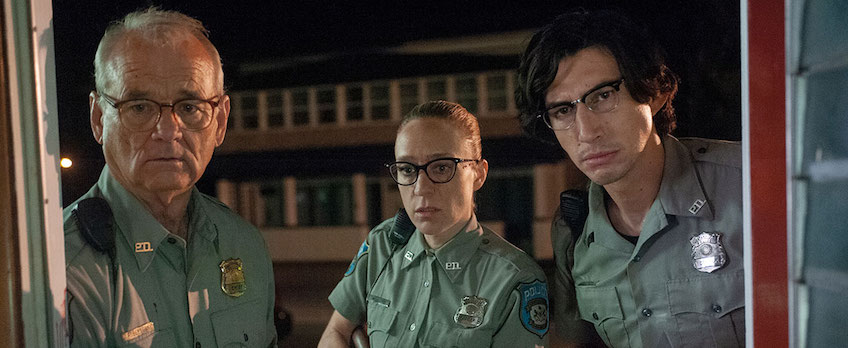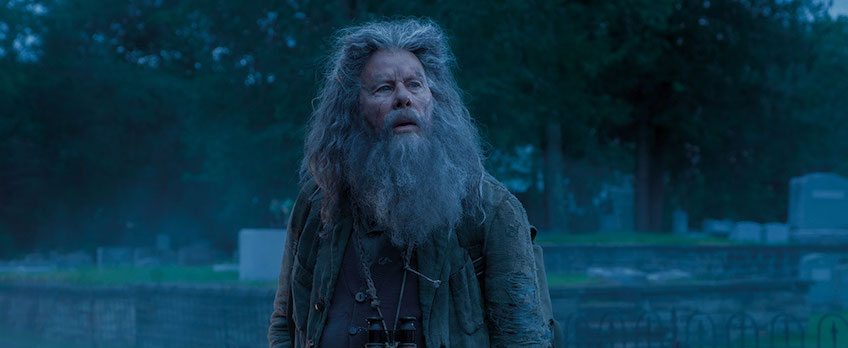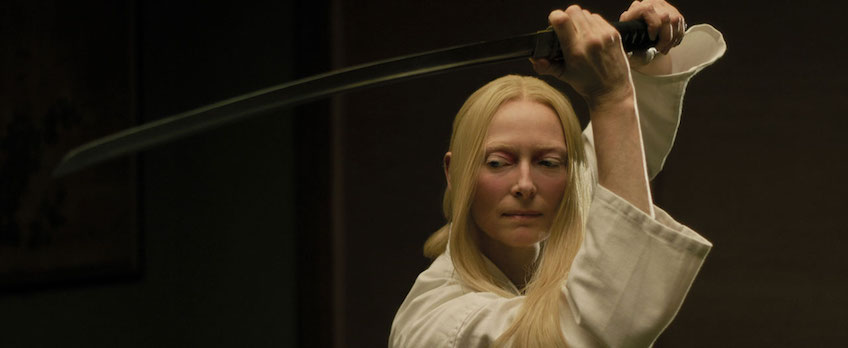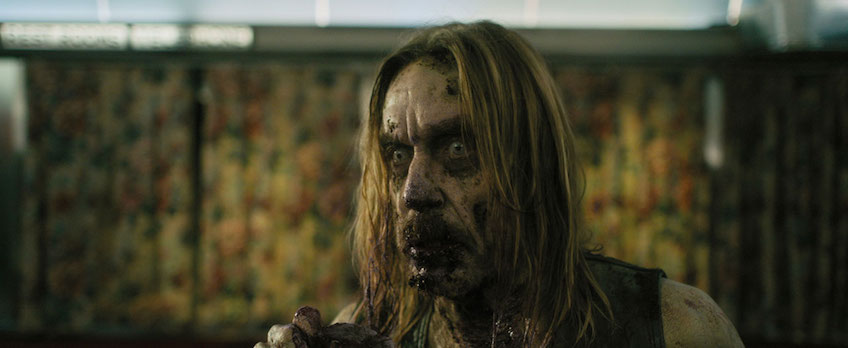Interested in writing for our blog? Send your pitches to editor@miff.com.au.
The Dead Don’t Die, Four Ways

During the 2019 Melbourne International Film Festival Critics Campus, our participants took part in a live-editing workshop. Four of them reviewed Jim Jarmusch’s The Dead Don’t Die, and then edited their drafts with one of this year's mentors, Dee Jefferson. Read their final reviews below – and don’t forget to check out all of our Critics Campus coverage on the MIFF Blog.
Review by Luke McCarthy
“Total planetary destruction”. These words, blunt as they are terrifying, fester beneath the laconic and affected surfaces of Jim Jarmusch’s b-movie pastiche, The Dead Don’t Die. Uttered early in the film, this line – nakedly terrifying though also equally inelegant – echoes the divisive but penetrating approach taken by Jarmusch in his angry call-to-action. The film, a scathing portrait of political disengagement, is explicitly informed by this fear.
The Dead Don’t Die is a genre film in capital letters. This is hardly Jarmusch’s first foray into genre: Only Lovers Left Alive (2013) told the story of two modern-day vampires, while Ghost Dog: The Way of the Samurai (1999) was a uniquely American samurai film. But The Dead Don’t Die – built around a series of vaguely connected vignettes – feels most connected to his earlier work, like the shorts comprising Coffee and Cigarettes (MIFF 2004).
The film documents the languorous take-over of the small town of Centerville by a horde of recently awakened undead. The reason for this awakening? Polar fracking, an exploitative practise which, within the bizarre world of The Dead Don’t Die, has thrown the earth off its axis. Watches stop, the sun doesn’t set: reality is crumbling.
Like the bold-block letters of ‘OBEY’ which hide behind the commercial billboards of John Carpenter's They Live (1988), or the white, generic labels which populate the shelves of Alex Cox's Repo Man (MIFF 1985), The Dead Don’t Die feels a throwback to the era of urgently anti-consumerist sci-fi which populated genre cinema in the 1980s. The difference between these gestures and the ‘KEEP AMERICA WHITE AGAIN’ slogan which sits atop of Steve Buscemi’s stark red cap are slight.
The film insistently references pop-culture: A Nosferatu t-shirt, a car which the characters call “Romero-esque.” These references are foregrounded as metacommentary. “This is the theme song,” says Adam Driver early in the film as Sturgill Simpson’s The Dead Don’t Die plays on a police car radio.
Jarmusch’s bluntness in these moments is comically ironic, which is not unfamiliar for the director. But here, it’s borne of anger - not detachment. The themes of this film are explicit and unsophisticated, and intentionally so.
There seems no smart way to parody or satirise something as already-blunt as “Make America Great Again.” Its awfulness is self-evident, demanding an urgency that openly defies the intellectual constructs of good taste. As we hear in the beginning of the film from RZA, one of the film’s many diverse and distinct characters: “The world is perfect. Appreciate the details”. Jarmusch does appreciate the details, and by laying them out so explicitly, The Dead Don’t Die forces us to question why we’ve stopped paying attention.

From The Dead Don't Die
Review by Claire Cao
In The Dead Don’t Die, director Jim Jarmusch attempts to spoof both the zombie genre and his trademark sardonic style. Beneath the film’s hyper-ironic surface simmers a sincere condemnation of the consumerism and political inaction that plagues our current political context. This critique, however, is ultimately bogged down with what feels like five hundred half-baked gags and nods to George Romero’s Dead films.
Set in a Midwestern American town, the simple premise follows a world caught in the throes of an environmental meltdown caused by so-called "polar fracking”. Extreme climate fluctuations lead to a chain of supernatural events drawn from the canon of apocalyptic thrillers: animals escape into the wild, technology conks out and the dead rise from their graves, hungry for flesh. The townspeople react with bland disinterest, preferring to complain about foreigners rather than listen to doom-saying scientists.
In this anti-thriller, the cast makes no attempt at passing as a believable small-town community, with almost every character played by an iconic Jarmusch collaborator – from police officers Cliff Robertson (Bill Murray) and Ronnie Peterson (Adam Driver) to Tilda Swinton as a katana-wielding mortician; indeed Swinton appears to parody both her character in Only Lovers Left Alive and her real-life vampire/alien/Celtic-adjacent/Orientalism-prone persona.
There are moments when Jarmusch's sense of weariness hits with clarity. The film’s constant celebrity cameos – from Selena Gomez as a “Cleveland hipster” to Iggy Pop as a coffee-obsessed zombie – lampoon the soulless absurdity of our brand-driven culture. Like in Romero’s Dawn of the Dead (1978), zombies are also closely linked to consumption; they pause from slurping intestines to moan about wanting iPhones, Xanax or a Wi-Fi connection. Living or undead, all characters are disengaged from their wider world, more concerned with useless, materialist minutiae. This sense of existential exhaustion with late Capitalism is evocatively portrayed through roaming shots of zombies pillaging stores, assisted by Frederick Elmes's ghostly cinematography of lightless roads strewn with dismembered appendages.
Despite striking images, the film’s cartoonish nature bleaches the urgency and emotional nuance out of the issues Jarmusch champions. Steve Buscemi’s turn as a small-minded racist wearing a hat that reads “Make America White Again,” and a plodding B-plot following a trio of black teen detainees, render timely political concerns like racism and mass incarnation into inconsequential asides. Ultimately, Jarmusch's homage to Romero lacks punch. Its emotional distance and barrage of meta jokes make it indistinguishable from an instalment of the Scary Movie franchise.

From The Dead Don't Die
Review by Zach Karpinellison
In The Dead Don’t Die Jim Jarmusch fails to reanimate a film that is cold as a corpse. The satirical zombie-flick has been divisive since its release at Cannes 2019. It’s drawn ire for its self-indulgence but also been praised for its star-studded charm. This critical-split skirts another reading: that the film fails to inspire a strong reaction at all.
Set in Centerville, a generic rural town, Jarmusch signals his continued interest in small-town America recalling films such as Mystery Train (1989) and Broken Flowers (2005). The story picks up as monotone police officers Cliff Robertson (Bill Murray) and Ronnie Peterson (Adam Driver) start noticing strange events around Centerville: daylight extends into night, ant hills swarm, and eventually zombies show up. The film’s explanation for these happenings is something to do with “polar fracking” causing the Earth to tip off its axis (wink wink, climate change).
Here lies the film’s tonal error. These self-aware explanations of impending catastrophe are depicted in tongue-in-cheek broadcasts, and through the musings of local Hermit Bob (Tom Waits). Each of these is steeped in political discourse about environmental crisis and capitalistic greed. But the film’s tone of deadpan self-referentiality and slow-paced ironic humour immediately wears away at the seriousness of these issues.
The effect is an emaciated skeleton of self-mocking social commentary that lacks poignancy. This commentary is punctuated by visual gags and surprising cameo appearances from the likes of Selena Gomez and a ghoul version of Iggy Pop. The sheer detail of Jarmusch’s self-reflexive paraphernalia is impressive and painstakingly executed. However, it’s unfortunate that a film that attempts to use its satirical edge to challenge apathy here comes short of conveying a strong political message beyond “just because.”
The director echoes the iconography of George Romero, in particular the critique of consumerism in 1978’s Dawn of the Dead (MIFF 2008). But this approach also lacks a critical edge. Pastiche is used, it seems, without comment.
Edgar Wright’s hyper-referential zombie parody film Shaun of the Dead (2004) resolves this problem by updating and evaluating the bank of films he references and clearly adores. In The Dead Don’t Die “Easter Eggs” are deployed for not much more than the acknowledgement that they’re “stuff” Jarmusch likes. They function like illustrative citations – demonstrating his zombie knowledge, but not really offering a critique of the Trump era. Even the casting is self-aware: Driver, Murray and Waits join Steve Buscemi, Chloë Sevigny and Tilda Swinton in returning to work with the director. They essentially play themselves.
The Dead Don’t Die is an ambitious film that regrettably trips over its own decaying feet. It spoon-feeds us cues for when to laugh, and then attempts to siphon a second round of humour with dispassionate fourth-wall-breaking acknowledgements that leave us zombified.

From The Dead Don't Die
Review by Zoë Almeida Goodall
The Dead Don't Die works best if you imagine it as a birthday present.
If you imagine that Bill Murray, Adam Driver, Tilda Swinton and other cult film darlings gathered together to film a bonkers, painfully self-aware zombie movie parody and then gave it to Jim Jarmusch as a birthday present, it's great.
Unfortunately, the film more often than not feels like self-indulgent chaos.
Our setting is the small town of Centerville, which, with its donuts and diners, calls to mind Twin Peaks without any of the charm. Murray, Driver and Chloë Sevigny play local cops, Tilda Swinton is the weird, sword-wielding Scottish undertaker, and various other indie favourites turn up in supporting roles. Watches have stopped, the sun isn't setting on time and mobile phones have died (although televisions haven't, for some reason). The dead are coming back to life. The cause is "polar fracking", which has disturbed the earth’s axis.
When the opening credits song starts playing on the radio and Officer Ronnie Peterson (Driver) states, "This is the theme song", you know this isn’t your average zombie movie. Unfortunately, this breaking of the fourth wall, whatever Jarmusch’s intentions, never does anything except strenuously try to prove the film's quirkiness. When the motif resurfaces much later, the point of it is still unclear.
Throughout the course of the narrative, The Dead Don't Die makes heavy-handed but ultimately ineffective comments on Trump, white supremacy, global warming and materialism. By the time aliens get involved, it appears Jarmusch is throwing anything at the wall to see if it sticks.
A final monologue on how everyone's a zombie, hungry for material possessions, is about as subtle as being hit by a bus, especially when accompanied by a collage of shambling zombies. Perhaps this belabouring of the point is entirely by design, but the film’s many layers of satire and self-awareness make it hard to discern the intended take-home message.
In the poster for Edgar Wright's Shaun of the Dead, another zombie parody film, Simon Pegg stands on a train surrounded by figures who could be zombies or could be dead-eyed commuters shuffling through their dull lives.
The Dead Don't Die is that poster as a two-hour movie, but without any of the subtlety or wry wit.
"This whole thing is gonna end badly," Ronnie repeats throughout the film. That, at least, is true.